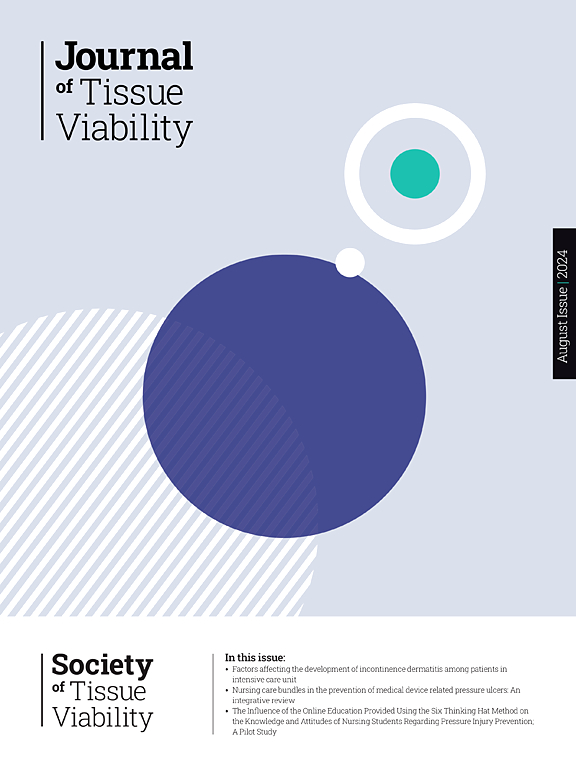术后重症监护病房用红外热像仪评价手术相关压力损伤
IF 2.4
3区 医学
Q2 DERMATOLOGY
引用次数: 0
摘要
目的应用红外热像仪监测重症监护室术后患者易压区皮肤温度,探讨影响压伤发生的因素。方法本前瞻性描述性研究对术后2小时以上入住重症监护病房的患者进行研究。与参考区域相比,骶骨、左右臀区、左右脚跟之间的皮肤温度差异使用红外热像仪测量。在进入重症监护室后立即进行了测量。分析患者临床状况与观察到的温差之间的相关性。结果本研究纳入59例患者,进行了590次热成像评估。参考区域与右脚跟(- 3.61°C)、左脚跟(- 3.34°C)、左臀区(- 2.9°C)、右臀区(- 2.89°C)和骶骨(- 2.47°C)之间存在温差。统计学上显著相关(p <;患者年龄、白蛋白和血红蛋白水平、体温差异均有0.05)。结论采用红外热像仪测量长期手术后压力损伤高危部位的体温差异。我们观察到,低白蛋白血症和低血红蛋白水平对骶骨、臀区和足跟的温差有显著的影响,尤其是在老年人中。红外热像仪在评估皮肤压力损伤风险方面比Braden风险评估量表更有效。建议采用更大样本量的进一步研究来证实这些发现。本文章由计算机程序翻译,如有差异,请以英文原文为准。
Evaluation of surgery-related pressure injury with infrared thermal camera in the postoperative intensive care unit
Objective
This study aimed to monitor skin temperature in pressure-prone areas of post-surgical patients in the intensive care unit using an infrared thermal camera and to examine the factors influencing the development of pressure injuries.
Methods
This prospective descriptive study was conducted on patients admitted to the intensive care unit following surgery lasting more than two hours. Skin temperature differences between the sacrum, right and left gluteal regions, and right and left heels, compared to reference regions, were measured using an infrared thermal camera. Measurements were taken immediately upon admission to the intensive care unit. The correlation between patients' clinical conditions and observed temperature differences was analyzed.
Results
The study included 59 patients and involved 590 thermographic evaluations. Temperature differences were identified between the reference areas and the right heel (−3.61 °C), left heel (−3.34 °C), left gluteal region (−2.9 °C), right gluteal region (−2.89 °C), and sacrum (−2.47 °C). A statistically significant correlation (p < 0.05) was found between patient age, albumin and hemoglobin levels, and temperature differences.
Conclusions
Temperature differences between the high-risk body parts of patients at risk of pressure injury after long-term surgery were measured using an infrared thermal camera. It is observed that, hypoalbuminemia, and low hemoglobin levels affect the temperature difference in the sacrum, gluteal region, and heels in a statistically significant way especially in advanced age. The infrared thermal camera proved to be more effective than the Braden Risk Assessment Scale in assessing skin for pressure injury risk. Further studies with larger sample sizes are recommended to confirm these findings.
求助全文
通过发布文献求助,成功后即可免费获取论文全文。
去求助
来源期刊

Journal of tissue viability
DERMATOLOGY-NURSING
CiteScore
3.80
自引率
16.00%
发文量
110
审稿时长
>12 weeks
期刊介绍:
The Journal of Tissue Viability is the official publication of the Tissue Viability Society and is a quarterly journal concerned with all aspects of the occurrence and treatment of wounds, ulcers and pressure sores including patient care, pain, nutrition, wound healing, research, prevention, mobility, social problems and management.
The Journal particularly encourages papers covering skin and skin wounds but will consider articles that discuss injury in any tissue. Articles that stress the multi-professional nature of tissue viability are especially welcome. We seek to encourage new authors as well as well-established contributors to the field - one aim of the journal is to enable all participants in tissue viability to share information with colleagues.
 求助内容:
求助内容: 应助结果提醒方式:
应助结果提醒方式:


